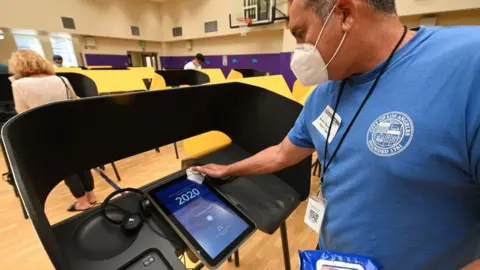US election 2020: When will we know the result?
 BBC
BBCThe polls have closed in the US presidential election but the race for the White House between Donald Trump and Joe Biden is still unresolved. Why?
It was always possible that we would not get a result on election night.
Millions more Americans have been voting by post due to coronavirus, which means a delay in counting all the votes was always likely.
When do we usually get a US election result?
The result is usually clear on the night of the election.
Different states stop voting at different times. The first polls closed on the East Coast at 19:00 local time (00:00 GMT).
This was followed by a running total of votes as they were reported in each state.
The full count is never completed on election night - that is normal - but enough votes are usually in to confirm a winner.
A state is "projected" by major US media outlets when they believe one candidate has an unbeatable lead.
That's not the final result but it nearly always proves to be correct when all the votes are counted.
US presidents are not decided by the national vote, but by winning enough states.
The winner in each state takes a certain number of "electoral votes" based roughly on the size of its population.
To win the White House, 270 electoral votes are needed.
In 2016, the election was called for Donald Trump at about 02:30 EST (07:30 GMT), after victory in Wisconsin put him over the 270.
Why is this year different?
The coronavirus pandemic means more people than ever are voting early, either by post or in person.
Postal votes typically take longer to count as they have to go through more steps to be verified, such as a signature and address check.

Some states such as Florida allowed this process to start weeks before election day, so the votes were ready to be counted.
That's why we have that prize already given tonight - to the president.
What states are we waiting on?
The race is coming down to a few states such as Arizona, Georgia, Wisconsin, Michigan and Pennsylvania.
These states could be crucial - but don't expect to get winners in all of them any time soon.
Pennsylvania and Wisconsin don't allow early votes to be processed until polling day, and election officials have warned that counts could take days.
Other key states such as Arizona, Georgia and Michigan are also still in the balance.
Arizona appears to be leaning towards Biden, and it would be the first time since 1996 that a Democrat won there.
If Biden is successful in Arizona, he would then need to win two of the three so-called "blue wall" states - Wisconsin, Michigan and Pennsylvania - to secure victory.
Although the former vice-president currently trails in all three, there are lots of postal votes still to count, and more Democrats have voted this way than Republicans.
Georgia is also in the balance, which has been safely Republican in recent years.
We are still waiting on Texas and North Carolina too, but they look to be safely in Trump's hands.
What else is delaying the count?
About half of states will accept postal ballots that arrive after election day, as long as they are postmarked by 3 November, so some votes won't be counted until days after the election.
There's also expected to be a rise in provisional ballots - votes cast by people who requested a postal ballot but decided to vote in person instead.
And these won't be included in the initial count, as they require checks to ensure people don't vote twice.
How are votes counted?
Most ballots - paper or digital - are counted by machines.
But poll workers need to check any paper ballots the machines fail to process.
After polls close, the voting data will be transferred to a central election headquarters - a city hall or similar location.
 Getty Images
Getty ImagesSometimes, this is done electronically.
But elsewhere, memory devices holding the voting data must be physically delivered or the results read out over the phone.
Once the vote tallies are delivered, they'll often start to show up on a state's official website.
In other cases, journalists are told the tallies by state election officials and report these results.
When enough votes have been tallied from across a state to determine an unbeatable lead, news organisations call a winning presidential candidate for that state.
These unofficial results are certified only weeks later, when confirmed by state officials.
The final vote tallies can shift between the first count and these certified results but not drastically.
What happens if the election results are disputed?
The pandemic has already led to more than 300 election law cases in 44 states, according the Stanford-MIT healthy-elections project.
And the presidential vote could see legal challenges over everything from identification requirements for postal voting to Covid-related changes to polling systems.
President Trump says the election result could end up in the US Supreme Court.
In 2000, Democrat Al Gore lost Florida and the presidential election by 537 out of a total of almost six million votes.
And this was followed by a highly controversial recount process that lasted over a month - and the Supreme Court ruling in favour of Republican George W Bush.



- Eat your way to power! Can a bacon sandwich affect your chances?
- Battle for the White House: Clive Myrie investigates what divides Americans (UK only)

